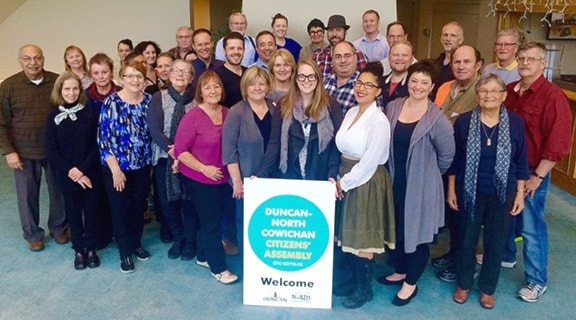The members of the long-anticipated Duncan-North Cowichan Citizens’ Assembly have been chosen and begun work.
The 36 members of the assembly, consisting of local residents who were randomly chosen, are tasked with considering the potential amalgamation of Duncan and North Cowichan.
During the next four months, the assembly will hear from more than 20 speakers, including experts in municipal governance as well as local business, civic and First Nation leaders.
The assembly will also receive the report of the technical consultants who have been hired to conduct a rigorous assessment of the proposed merger.
“The decision to merge two municipalities has far-reaching consequences and deserves careful examination,” said assembly chairman Peter MacLeod.
“The citizens’ assembly is a sincere effort to bring local residents to the table and provide clear guidance to both councils.”
The final report from the citizens’ assembly is expected to be presented to both municipalities in May.
Duncan, at 2.07 square kilometres, is the smallest city by area in Canada. It was incorporated in 1912 after separating from North Cowichan.
Duncan is dwarfed by North Cowichan, which is 194 square kilometres, and one of the main advantages of amalgamation would be the ability to cut costs by combining and streamlining duel bureaucracies and services in the two municipalities.
During the 2014 municipal election, Duncan and North Cowichan each included a non-binding question on their ballots regarding amalgamation of the two municipalities.
In North Cowichan, 68 per cent favoured conducting a study to explore the costs and benefits of amalgamation, while 52 per cent of voters in Duncan were in favour.
To keep the amalgamation study as unbiased as possible, both councils agreed to establish the independent citizens’ assembly, which will consider the results of the study and make recommendations to both councils at a joint meeting.
If all aspects of the plan fall into place in time, residents of North Cowichan and Duncan could decide in a referendum, which could be held on Oct. 20, 2018, whether to amalgamate the two municipalities.
If, at the end of the process, both municipalities agree to amalgamate, that process will likely take up all of the four years between 2018 and 2022, when the next municipal election will be held.
The members of the citizens’ assembly were selected in a blind draw designed to produce a group that is gender balanced and that roughly matches the demographic profiles in both communities.
People interested in learning about the citizens’ assembly and sharing their views on municipal amalgamation are encouraged to attend two public roundtable meetings that are scheduled.
The first is on Feb. 2, from 7 p.m. to 9 p.m., at the Island Savings Centre, and the other will be held on April 6, also from 7 p.m. to 9 p.m., at the Island Savings Centre.
